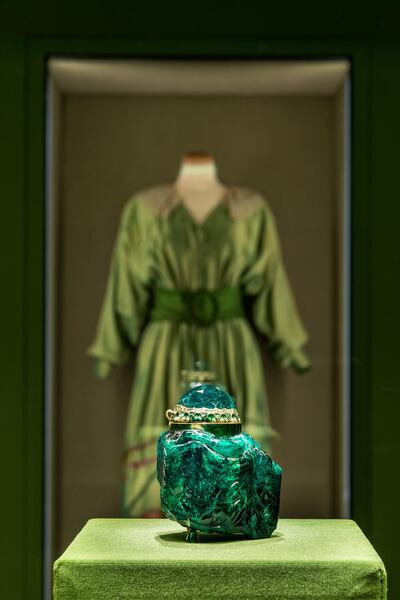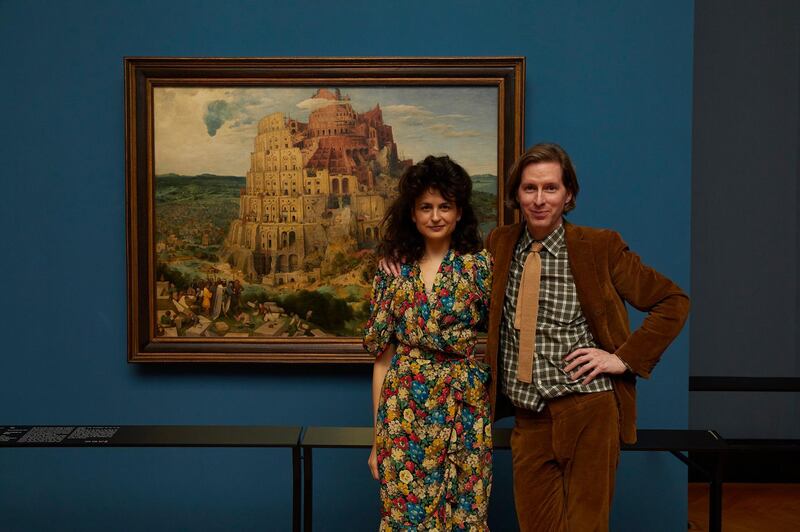It was supposed to take two-and-a- half weeks – and instead turned into a two-and-a-half-year ordeal.
We're referring to the highly anticipated collaboration between the most fantastical filmmaker in the world, Wes Anderson, along with his writer-illustrator partner Juman Malouf, the Prada foundation and the Kunsthistorisches Museum in Vienna. The Austrian museum opened its entire historical collection of nearly 4.5 million works of art, spanning 5,000 years, to the couple, for an exhibit titled Spitzmaus Mummy in a Coffin and Other Treasures. The exhibition opened last week, with a crowd of VIPs, friends of the couple such as Tilda Swinton and Jason Schwartzman, as well as hundreds of Anderson aficionados in attendance.
The filmmaker and his muse as museum curators – now what could go wrong? Well, according to the critics, who are always plentiful and noisy whenever an artist tries something new, the resulting exhibit is too closely tied with the director's need to manipulate his audience into feeling sentiments for the collections of objects, instead of allowing us to view them as individual masterpieces in their own right. But to someone who is completely enamoured with Anderson's aesthetics and elegant style, it's like a walk through a very classy toy store, complete with goodies in every room.
At its centre is the tiny Spitzmaus (pigmy shrew) mummy, an ancient Egyptian artefact that gives the exhibition its name, and is housed in a container no bigger than a shoebox. Called a "collection of misfits" by ArtNet, which also summarises the show as "enchanting", Anderson and Malouf's heartfelt assemblages ran into very practical problems early on in their selection. And while a museum curator would know about humidity requirements and display materials essential to each particular object, the couple needed to learn about such factors, which contributed in part to the great delay in putting the collection together.

But the result – the emotional impact of seeing the grand emerald-green room that the couple have assembled and that grouping of paintings of plump, aristocratic children dressed as clergy and royalty, is fantastic. While many of us are used to going to a museum and seeing room after room arranged by era, artist or historical significance, we’ve never before stepped into the magical vision of a Wes Anderson museum. It’s an extraordinary place where timing and provenance aren’t as important as the visual aesthetic and emotional sensation that the artworks create within us.
It’s as if the American-born Anderson and Malouf, who is from Beirut, used the Austrian archives of one of the largest collections of artefacts in the world as their own cast of characters, to tell us the story of our humanity. A green dress worn by Austrian actress Erika Pluhar on the stage in the late 1970s and a pair of Fayum portraits live equally at home on the set of this latest project, and the quirky curators, in the process, teach us how to truly view art, with the eyes of a dreamer.

Perhaps the couple also set out to teach us how, in our multicultural and globalised world, the old methods of looking at artworks are outdated. Cinema and the visual arts need to be viewed across many disciplines, and not get stuck in theoretical boxes. Even the sensory experience of adding carpeting in the room where the children's portraits are housed enhances the abstract feeling that we're walking through a nursery, albeit one where only the portraits of the kids remain.
It doesn't hurt, of course, that the Kunsthistorisches Museum looks like it could double as the set of Anderson's The Grand Budapest Hotel, and its facade possesses the perfect blend of beauty and symmetry the filmmaker's work usually requires. In fact, it is his sense of perfectly mirrored proportions that has inspired endless sites, articles and the wildly successful "Accidentally Wes Anderson", a community of aesthetes who share their views of the filmmaker's splendour through a blog and on Instagram.
______________________
Read more:
Film review: Isle of Dogs is visually stunning, but culturally questionable
Liev Schreiber on Isle of Dogs: 'As a dog lover I see the film as an homage'
______________________
The exhibition will travel to Milan next year, where it will be displayed at the Prada Foundation, and that should also prove a challenge, since many of the pieces included are as old as man himself. Spitzmaus Mummy in a Coffin and Other Treasures is the third collaborative project of its kind by the Kunsthistorisches Museum, the first realised by artist Ed Ruscha, followed in 2016 by an exhibition selected and curated by the British ceramicist and writer Edmund de Waal.
So after all was said and done, what does Anderson think of the resulting effort? “It was probably worth it,” he admitted shyly, during his ultra- succinct speech on the night of the opening reception.
Spitzmaus Mummy in a Coffin and Other Treasures runs until April 28 at the Kunsthistorisches Museum in Vienna





